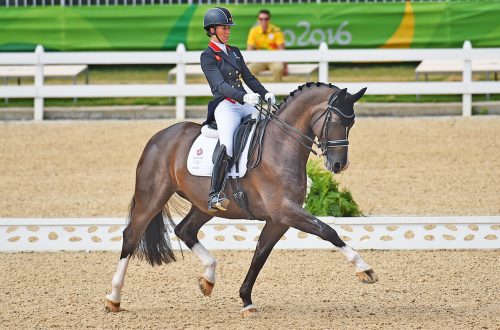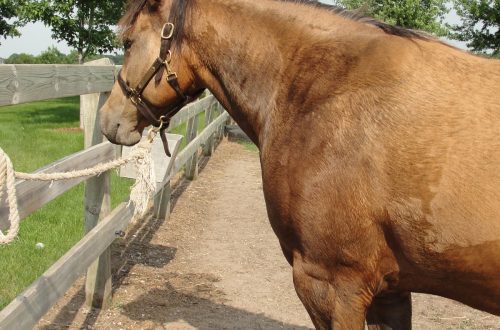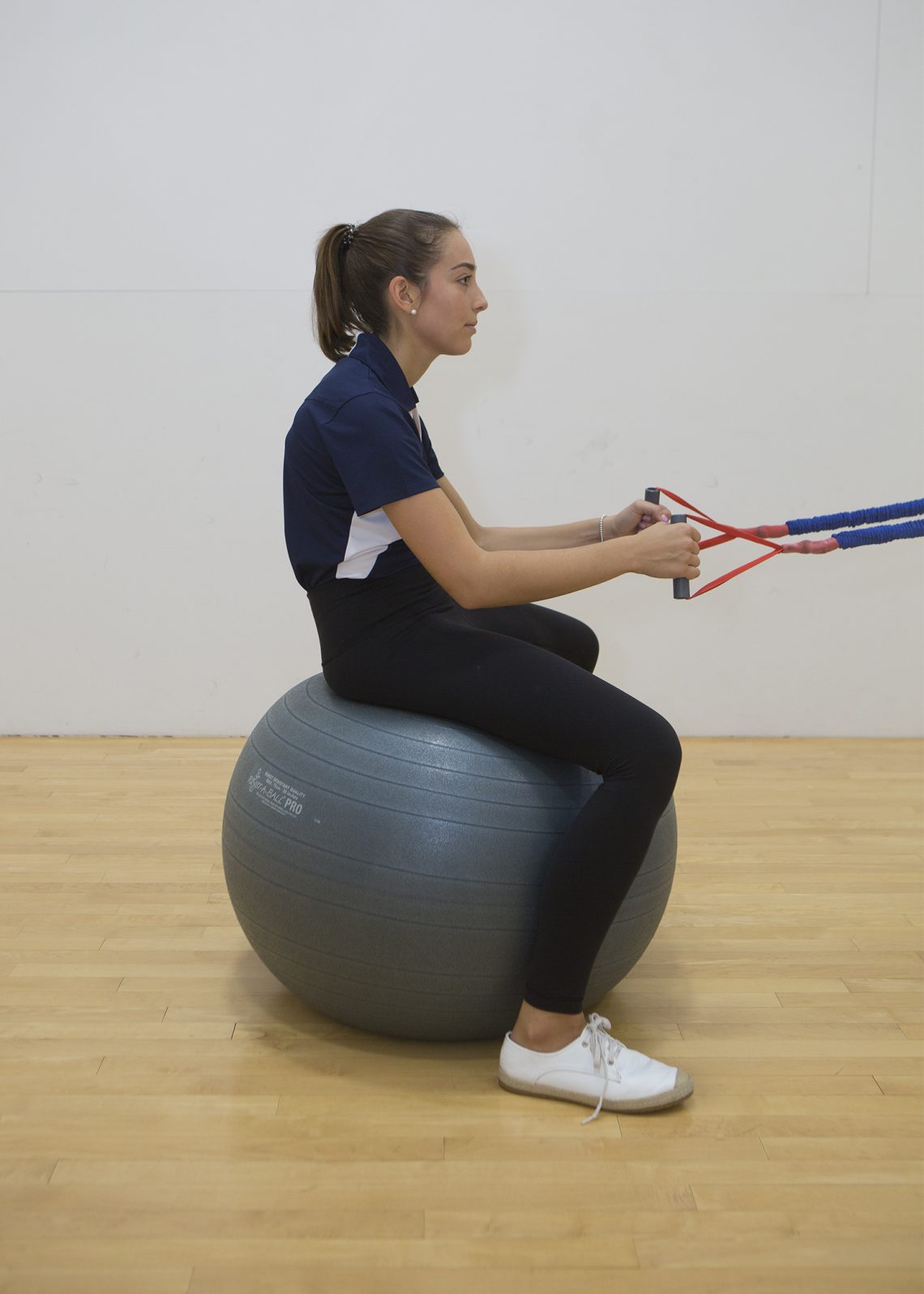
Instructor Help: Trot Exercises
Instructor Help: Trot Exercises
My article is addressed primarily to riding instructors (coaches), but I hope that it can be useful for independent riders as well! I want to share with you a few exercises that I use regularly in my workouts.
1. Exercise “Up-up-down”, or riding at two paces
When the rider rides at a posting trot, he relieves himself and lowers himself into the saddle – “up and down”. After the rider has warmed up by riding a posting trot for a few laps, ask him to ride two paces – Up-Up-Down. Thus, the rider will have to stand two strokes of the trot and sit one, continuously.
This exercise helps the rider find their balance in the forward movement and stabilize the leg position. It can be performed on the lunge or with the rider independently riding in circles.
2. Exercise “5-5-5”
This exercise can have several variations. Its advantages are as follows:
Work on skills is “broken down” into small pieces that can be overcome, given the level of preparation and physical development. The exercise involves counting and predictability, which is very convenient for beginner riders. Counting your horse’s steps helps you learn to feel and understand his movements. A large number of repetitions gives the rider more room to improve, build confidence and build muscle memory
2.1. “5-5-5 – Landing”
The rider takes 5 steps in a two-point landing, 5 steps in ease, 5 steps in a training trot.
This exercise is good for warming up. It strengthens leg muscles, improves balance and corrects the position of the legs.
I like to do it on the lunge because it makes it easier for the rider to work on his position.
2.2. ‘5-5-5 – Lynx-Step-Lynx “
Counting to five, the rider rides at a pace, then at a trot, and then at a pace again.
I recently used this exercise with a rider who was nervous at the trot due to a bad fall and it really helped. Knowing that he would only have to trot until I counted to five made him less and less nervous. He also did not allow the horse to rush and rush, rode with a trot, smoothly and gently, this allowed him not to jump in the saddle and sit more correctly. As a result, he became much more confident in himself.
How we worked:
1) Trot – 5 bars long wall
- count aloud: for stride 1-2-3-4-5, for trot 1-2-3-4-5, for stride 1-2-3-4-5;
- we used the first 5 steps to prepare for the trot, then we asked the horse to speed up;
- when the rider dealt with this, he began to count himself, and I prompted “get ready for the trot”, “sit high, hands off the saddle.”
2) Trot 5 bars twice long wall
- we did everything as described above, but now the reprise of the trot was repeated twice;
- at first we counted together, then the rider began to count himself.
3) 5-5-5 -1 lap around the arena
We continuously alternated 5 trots and 5 steps until we completed a full circle around the arena.
4) An increase in the number of lynx
The next step we took with this rider was to extend the trot: now he was doing not 5-5-5, but 5-8-5 and 5-10-5. In the end, he calmed down enough that he was able to trot the entire arena.
3. Exercise on the figure “Zigzag”
This exercise aims to develop lateral balance for riders who have difficulty turning and turning. To work on it, you will need an even number of cones (4-8).
Preparing the arena:
- We arrange 4 cones in the arena along the zigzag path (if you wish, you can use more cones).
- We place a pair of cones on the letters A and C to indicate the turn to the center line.
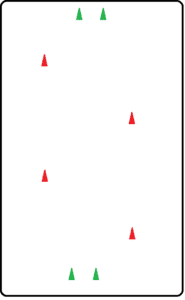
Increasing the difficulty of the task:
We complicate the rider’s task of controlling his lateral balance by asking him to perform sharper, tighter turns.
1) A small narrow zigzag from cone to cone. The rider rides inside a track of cones.
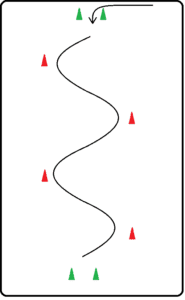
2) Big sharp zigzag from cone to cone. The rider leaves the cones.
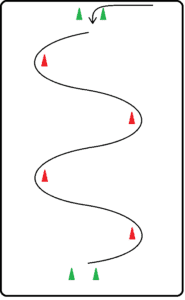
3) Large circles around the cones, leaving the center line.
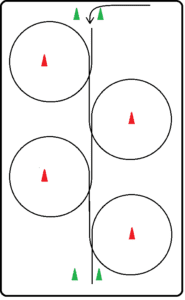
4) Small circles around the cones in a zigzag path. The exercise is performed as the previous one, but the smaller the circle, the more the trajectory of movement along the center line turns into a zigzag.
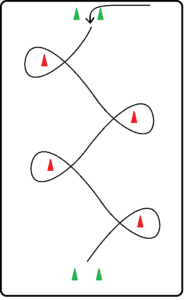
5) 1,5 laps around the cone, driving outside / from the side of the walls of the arena.
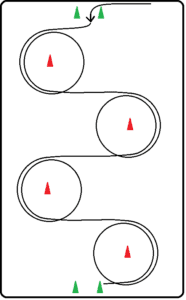
Remind the rider to look in the direction of the turn while turning the horse and maintain eye contact with the trainer.
Working with templates:
- First, the rider rides along a zigzag path that goes beyond the cones, 2 times.
- Then he rides on the template, making circles on the quarter line, 2 times.
- Further, the task becomes more complicated – the transition to smaller circles.
- We change direction, the horse should work out as many turns to the left as to the right.
- Do at least 4 sets in each direction.
4. Pattern for trotting
This scheme can be used if the rider is already quite confident in the trot.
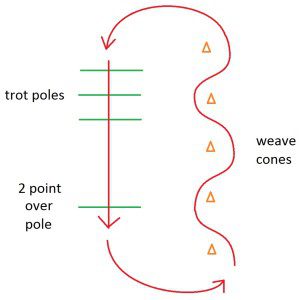
This exercise includes:
- Management is an external and internal cause.
- Half halts – preparation for each element.
- Two-point landing – when riding on a single pole (the horse can even jump it).
During the warm-up, you can walk a circle around the arena, then drive a circle at a drill trot, another half circle in a two-point landing, half a circle at two paces (stand up, stand up, sit down). Change direction and repeat.
The practiced skill is a half halt.
Before starting, the rider circles the trot in each direction, performing half halts before entering each corner.
Exercise:
Riding in a pattern, half halts before each element and turn.
- We start the circuit with cones on a snake, do half halts to rebalance the horse. Don’t forget to level it.
- Half halt before turning.
- Turn and exit to the poles, half halt to rebalance the horse.
- Lynx on poles.
- Half halt in front of a single pole to rebalance the horse.
- Two-point landing over the pole, trotting or jumping.
- Half halt to rebalance the horse before the turn.
- Repeat until success.
5. Riding in an X-shaped trajectory at the posting and training trot
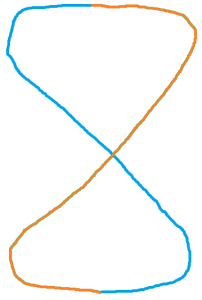
- We ride half of the X trajectory at a training trot.
- The other half is a combatant.
- Try to make the transition from combat to training and vice versa on the letters C and A.
Here are some examples of how and when to use this exercise:
Training trot
- Вthe gardener is already familiar with the posting trot and must work out the skill of riding a training trot.
- Learning the training trot.
- Practicing the training trot, riding half the long wall of the arena with a couple of steps as the rider starts to hit.
- Progress – riding along the entire long wall of the arena at a training trot.
- We increase the distance – we go a long diagonal training trot.
- Ride from A to C using an X pattern, alternating between training and posting trot.
Facilitate under the correct diagonal
- Вthe gardener is already familiar with the posting and training trot and you need to work on the diagonals.
- Learning to ease under the correct diagonal.
- We practice riding under the correct diagonal along the walls of the arena, determining the correct diagonal by the rider.
- We complicate the task – riding in an X-shaped pattern, alternating training and posting trot, practicing determining the correct diagonal when moving from training trot to posting.
Transition between posting and training trot
Often the rider, when transitioning from a drill trot to a training trot and vice versa, begins to interfere with the horse, pulling on the reins, disturbing the balance and slowing it down. That is why it is so important to practice these transitions. You can start doing them along the walls of the arena, and then move on to working on the X-shaped pattern.
Cynthia Linsenbart. Translation by Valeria Smirnova based on materials from the site http://www.lessonsintr.com.



